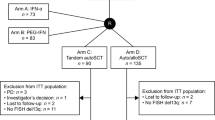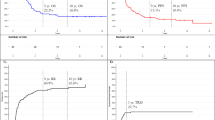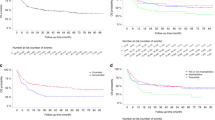Abstract
We evaluated 71 patients treated with allogeneic hematopoietic cell transplantation (allo-HCT) for multiple myeloma (MM). Forty-three patients (61%) received allo-HCT after the first line of therapy. Fifty-eight patients (82%) had chemosensitive disease at the time of allo-HCT. A HLA-matched related or unrelated donor was available for 68 patients (96%). Non-myeloablative or reduced-intensity conditioning regimen and peripheral blood hematopoietic cells as a graft source were used in most patients. The cumulative incidence of grade II–IV acute GVHD at day +100 and chronic GVHD at 5 years was 13% (95% CI 7–23%) and 35% (95% CI 24–46), respectively. Non-relapse mortality and relapse/progression incidence at 5 years were 12% (95% CI 5–23) and 65% (95% CI 49–76), respectively. With a median follow-up in survivors of 100 months (range 16–186), the 5-year PFS and OS were 39% (95% CI 27–52) and 60% (95% CI 55–77), respectively. On multivariate analysis: age >55 years was associated with both a reduced PFS (RR 2.11, 95% CI 1.15–3.87) and OS (RR 5.53, 95% CI 2.22–13.76); chemorefractory disease at allo-HCT was associated with both reduced PFS (RR 3.09, 95% CI 1.37–7.00) and OS (RR 3.19, 95% CI 1.23–8.22). At relapse, 24 patients (56%) received bortezomib, 28 (65%) lenalidomide, 11 (26%) pomalidomide, 16 (37%) donor lymphocytes infusion as part of salvage therapy after allo-HCT relapse. Median PFS from time of salvage treatment was 7 months (range 0–113 months) for bortezomib-based therapy, 14 months (range 0–79 months) for lenalidomide and 10 months (range 1–28) for pomalidomide. Allo-HCT is a feasible and effective strategy in selected patients with MM and could be an effective platform for subsequent therapies.
This is a preview of subscription content, access via your institution
Access options
Subscribe to this journal
Receive 12 print issues and online access
$259.00 per year
only $21.58 per issue
Buy this article
- Purchase on Springer Link
- Instant access to full article PDF
Prices may be subject to local taxes which are calculated during checkout


Similar content being viewed by others
References
Donato ML, Siegel DS, Vesole DH, McKiernan P, Nyirenda T, Pecora AL et al. The graft-versus-myeloma effect: chronic graft-versus-host disease but not acute graft-versus-host disease prolongs survival in patients with multiple myeloma receiving allogeneic transplantation. Biol Blood Marrow Transplant 2014; 20: 1211–1216.
Salama M, Nevill T, Marcellus D, Parker P, Johnson M, Kirk A et al. Donor leukocyte infusions for multiple myeloma. Bone Marrow Transplant 2000; 26: 1179–1184.
Stern M, de Wreede LC, Brand R, van Biezen A, Dreger P, Mohty M et al. Sensitivity of hematological malignancies to graft-versus-host effects: an EBMT megafile analysis. Leukemia 2014; 28: 2235–2240.
Rajkumar SV, Dimopoulos MA, Palumbo A, Blade J, Merlini G, Mateos M-V et al. International Myeloma Working Group updated criteria for the diagnosis of multiple myeloma. Lancet Oncol 2014; 15: e538–e548.
Sorror ML, Giralt S, Sandmaier BM, De Lima M, Shahjahan M, Maloney DG et al. Hematopoietic cell transplantation specific comorbidity index as an outcome predictor for patients with acute myeloid leukemia in first remission: combined FHCRC and MDACC experiences. Blood 2007; 110: 4606–4613.
Rowlings PA, Przepiorka D, Klein JP, Gale RP, Passweg JR, Henslee-Downey PJ et al. IBMTR severity index for grading acute graft-versus-host disease: retrospective comparison with Glucksberg grade. Br J Haematol 1997; 97: 855–864.
Filipovich AH, Weisdorf D, Pavletic S, Socie G, Wingard JR, Lee SJ et al. National Institutes of Health consensus development project on criteria for clinical trials in chronic graft-versus-host disease: I. Diagnosis and staging working group report. Biol Blood Marrow Transplant 2005; 11: 945–956.
Iacobelli S . Suggestions on the use of statistical methodologies in studies of the European Group for Blood and Marrow Transplantation. Bone Marrow Transplant 2013; 48 (March): S1–S37.
StataCorp 2013. Stata Statistical Software: Release 13. College Station, TX: StataCorp LP. n.d..
R Core Team R: A Language and Environment for Statistical Computing. R Foundation for Statistical Computing: Vienna, Austria, 2013. ISBN 3-900051-07-0. http://www.R-project.org/.
Montefusco V, Spina F, Patriarca F, Offidani M, Bruno B, Montanari M et al. Bortezomib plus dexamethasone followed by escalating donor lymphocyte infusions for patients with multiple myeloma relapsing or progressing after allogeneic stem cell transplantation. Biol Blood Marrow Transplant 2013; 19: 424–428.
Crawley C, Szydlo R, Lalancette M, Bacigalupo A, Lange A, Brune M et al. Outcomes of reduced-intensity transplantation for chronic myeloid leukemia: an analysis of prognostic factors from the Chronic Leukemia Working Party of the EBMT. Blood 2005; 106: 2969–2976.
de Lavallade H, El-Cheikh J, Faucher C, Fürst S, Stoppa A-M, Coso D et al. Reduced-intensity conditioning allogeneic SCT as salvage treatment for relapsed multiple myeloma. Bone Marrow Transplant 2008; 41: 953–960.
Walker I, Panzarella T, Couban S, Couture F, Devins G, Elemary M et al. Pretreatment with anti-thymocyte globulin versus no anti-thymocyte globulin in patients with haematological malignancies undergoing haemopoietic cell transplantation from unrelated donors: a randomised, controlled, open-label, phase 3, multicentre trial. Lancet Oncol 2015; 17: 164–173.
Rosiñol L, Jiménez R, Rovira M, Martínez C, Fernández-Avilés F, Marín P et al. Allogeneic hematopoietic SCT in multiple myeloma: long-term results from a single institution. Bone Marrow Transplant 2015; 50: 658–662.
Kröger N, Solano C, Wolschke C, Bandini G, Patriarca F, Pini M et al. Antilymphocyte globulin for prevention of chronic graft-versus-host disease. N Engl J Med 2016; 374: 43–53.
Bruno B, Rotta M, Patriarca F, Mordini N, Allione B, Carnevale-Schianca F et al. A comparison of allografting with autografting for newly diagnosed myeloma. N Engl J Med 2007; 356: 1110–1120.
Garban F, Attal M, Michallet M, Hulin C, Bourhis JH, Yakoub-Agha I et al. Prospective comparison of autologous stem cell transplantation followed by dose-reduced allograft (IFM99-03 Trial) with tandem autologous stem cell transplantation (IFM99-04 Trial) in high-risk de novo nultiple myeloma. Blood 2006; 107: 3474–3480.
Minnema MC, van Dorp S, van de Donk NWCJ, Schouten F, Kersten MJ, Coenen JLLM et al. Prognostic factors and outcome in relapsed multiple myeloma after nonmyeloablative allo-SCT: a single center experience. Bone Marrow Transplant 2011; 46: 244–249.
Kröger N, Shimoni A, Schilling G, Schwerdtfeger R, Bornhäuser M, Nagler et al. Unrelated stem cell transplantation after reduced intensity conditioning for patients with multiple myeloma relapsing after autologous transplantation. Br J Haematol 2010; 148: 323–331.
Badros A, Barlogie B, Siegel E, Cottler-Fox M, Zangari M, Fassas A et al. Improved outcome of allogeneic transplantation in high-risk multiple myeloma patients after nonmyeloablative conditioning. J Clin Oncol 2002; 20: 1295–1303.
Rotta M, Storer BE, Sahebi F, Shizuru JA, Bruno B, Lange T et al. Long-term outcome of patients with multiple myeloma after autologous hematopoietic cell transplantation and nonmyeloablative allografting. Blood 2009; 113: 3383–3391.
Rosiñol L, Pérez-Simón JA, Sureda A, de la Rubia J, de Arriba F, Lahuerta JJ et al. A prospective PETHEMA study of tandem autologous transplantation versus autograft followed by reduced-intensity conditioning allogeneic transplantation in newly diagnosed multiple myeloma. Blood 2008; 112: 3591–3593.
Giaccone L, Storer B, Patriarca F, Rotta M, Sorasio R, Allione B et al. Long-term follow-up of a comparison of nonmyeloablative allografting with autografting for newly diagnosed myeloma. Blood 2011; 117: 6721–6727.
Gahrton G, Iacobelli S, Bjorkstrand B, Hegenbart U, Gruber A, Greinix H et al. Autologous/reduced-intensity allogeneic stem cell transplantation vs autologous transplantation in multiple myeloma: long-term results of the EBMT-NMAM2000 study. Blood 2013; 121: 5055–5063.
Richardson PG, Sonneveld P, Schuster MW, Irwin D, Stadtmauer EA, Facon T et al. Bortezomib or high-dose dexamethasone for relapsed multiple myeloma. N Engl J Med 2005; 352: 2487–2498.
Dimopoulos M, Spencer A, Attal M, Prince HM, Harousseau J-L, Dmoszynska A et al. Lenalidomide plus dexamethasone for relapsed or refractory multiple myeloma. N Engl J Med 2007; 357: 2123–2132.
Madan S, Lacy MQ, Dispenzieri A, Gertz MA, Buadi F, Hayman SR et al. Efficacy of retreatment with immunomodulatory drugs (IMiDs) in patients receiving IMiDs for initial therapy of newly diagnosed multiple myeloma. Blood 2011; 118: 1763–1765.
McDaniel JM, Pinilla-Ibarz J, Epling-Burnette PK . Molecular action of lenalidomide in lymphocytes and hematologic malignancies. Adv Hematol 2012; 2012: 513702.
Gorgun G, Samur MK, Cowens KB, Paula S, Bianchi G, Anderson JE et al. Lenalidomide enhances immune checkpoint blockade-induced immune response in multiple myeloma. Clin Cancer Res 2015; 21: 4607–4618.
Kneppers E, van der Holt B, Kersten M-J, Zweegman S, Meijer E, Huls G et al. Lenalidomide maintenance after nonmyeloablative allogeneic stem cell transplantation in multiple myeloma is not feasible: results of the HOVON 76 trial. Blood 2011; 118: 2413–2419.
Alsina M, Becker PS, Zhong X, Adams A, Hari P, Rowley S et al. Lenalidomide maintenance for high-risk multiple myeloma after allogeneic hematopoietic cell transplantation. Biol Blood Marrow Transplant 2014; 20: 1183–1189.
Kröger N, Zabelina T, Klyuchnikov E, Kropff M, Pflüger K-H, Burchert A et al. Toxicity-reduced, myeloablative allograft followed by lenalidomide maintenance as salvage therapy for refractory/relapsed myeloma patients. Bone Marrow Transplant 2013; 48: 403–407.
Weisel K, Dimopoulos M, Song KW, Moreau P, Palumbo A, Belch A et al. Pomalidomide and low-dose dexamethasone improves health-related quality of life and prolongs time to worsening in relapsed/refractory patients with multiple myeloma enrolled in the MM-003 randomized phase III trial. Clin Lymphoma Myeloma Leuk 2015; 15: 519–530.
Sehgal K, Das R, Zhang L, Verma R, Deng Y, Kocoglu M et al. Clinical and pharmacodynamic analysis of pomalidomide dosing strategies in myeloma: impact of immune activation and cereblon targets. Blood 2015; 125: 4042–4051.
Giralt S, Garderet L, Durie B, Cook G, Gahrton G, Bruno B et al. American Society of Blood and Marrow Transplantation, European Society of Blood and Marrow Transplantation, Blood and Marrow Transplant Clinical Trials Network, and International Myeloma Working Group Consensus Conference on Salvage Hematopoietic Cell Transplantation in Patients with Relapsed Multiple Myeloma. Biology Blood Marrow Transplant 2015; 21: 2039–2051.
Acknowledgements
We gratefully acknowledge all patients and their families. Daniela Majerna and Anna Maria De Filippo helped in revising the manuscript. The study was supported by Associazione Italiana per la Ricerca sul Cancro (AIRC) and Associazione Italiana contro le Leucemie-Linfomi e Mieloma ONLUS (AIL).
Author contributions
Conception and design: PC, VM and AM; collection and assembly of data: AM, FR, MC, CdP, MP and FM; data analysis: AM and VM; interpretation: VM, AM and PC; manuscript writing: first draft prepared by VM and AM. All authors helped revising the manuscript. Final approval of manuscript was done by all authors.
Author information
Authors and Affiliations
Corresponding author
Ethics declarations
Competing interests
The authors declare no conflict of interest.
Additional information
Supplementary Information accompanies this paper on Bone Marrow Transplantation website
Supplementary information
Rights and permissions
About this article
Cite this article
Montefusco, V., Mussetti, A., Rezzonico, F. et al. Allogeneic stem cell transplantation and subsequent treatments as a comprehensive strategy for long-term survival of multiple myeloma patients. Bone Marrow Transplant 52, 1602–1608 (2017). https://doi.org/10.1038/bmt.2017.183
Received:
Revised:
Accepted:
Published:
Issue Date:
DOI: https://doi.org/10.1038/bmt.2017.183
This article is cited by
-
Current Role of Allogeneic Stem Cell Transplantation in Multiple Myeloma
Oncology and Therapy (2022)
-
Outcomes in newly diagnosed young or high-risk myeloma patients receiving tandem autologous/allogeneic transplant followed by bortezomib maintenance: a phase II study
Bone Marrow Transplantation (2022)
-
Time from autologous to allogeneic hematopoietic stem cell transplantation impacts post-transplant outcomes in multiple myeloma
Bone Marrow Transplantation (2020)



